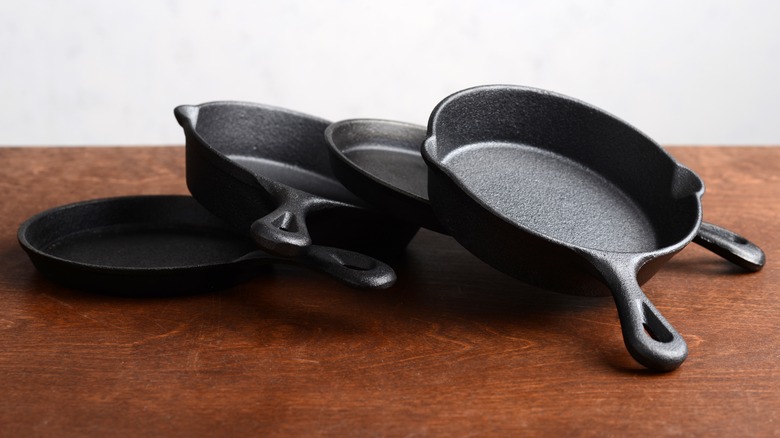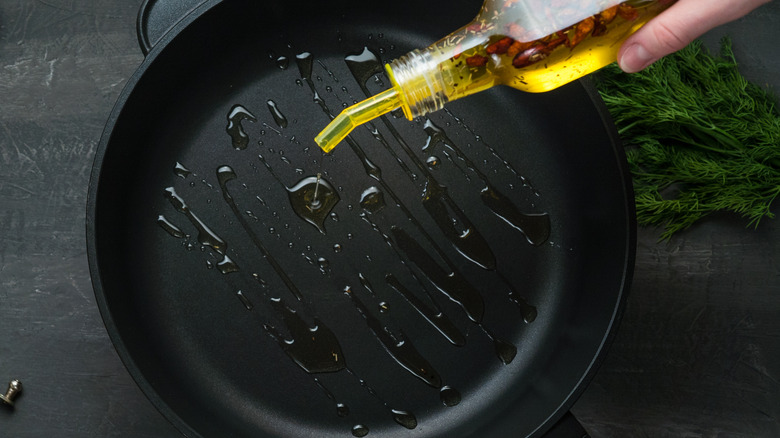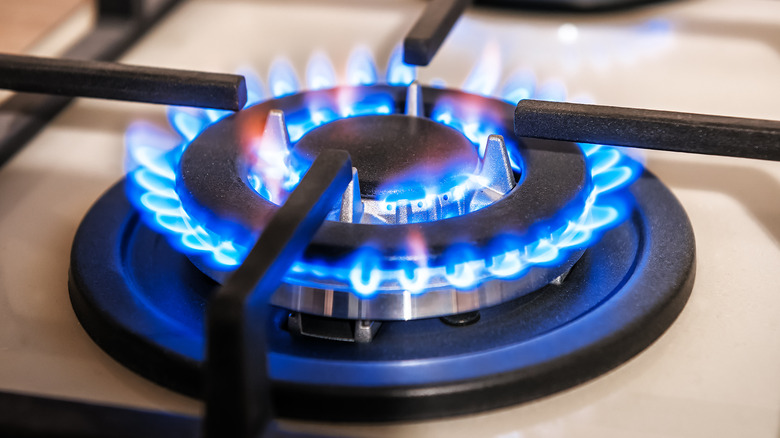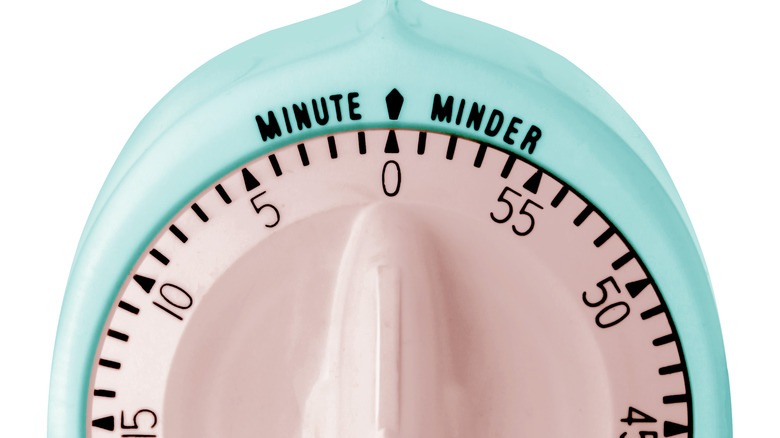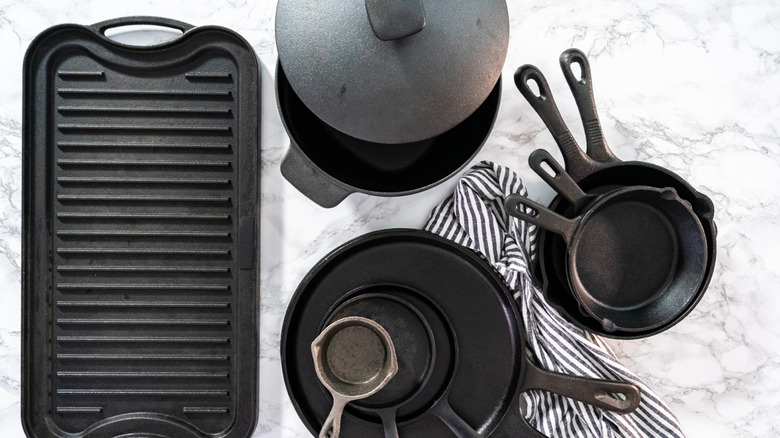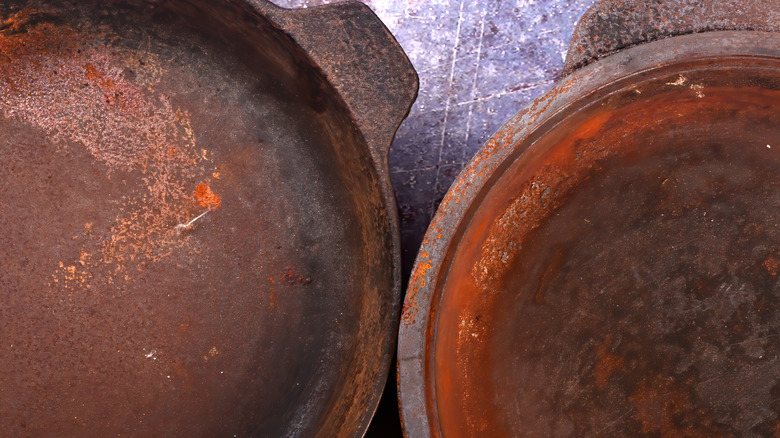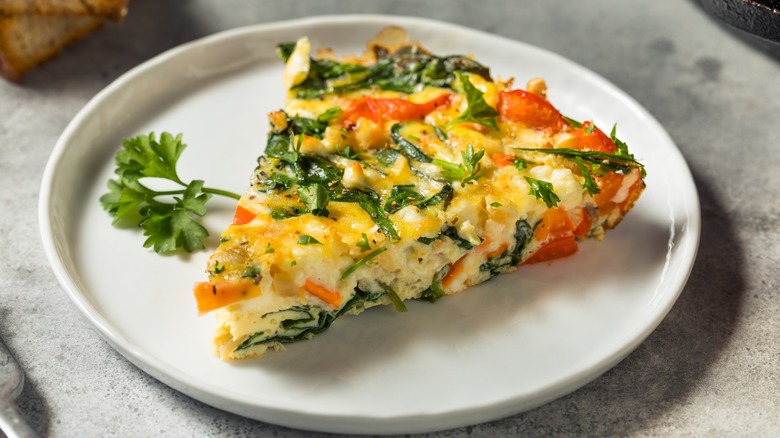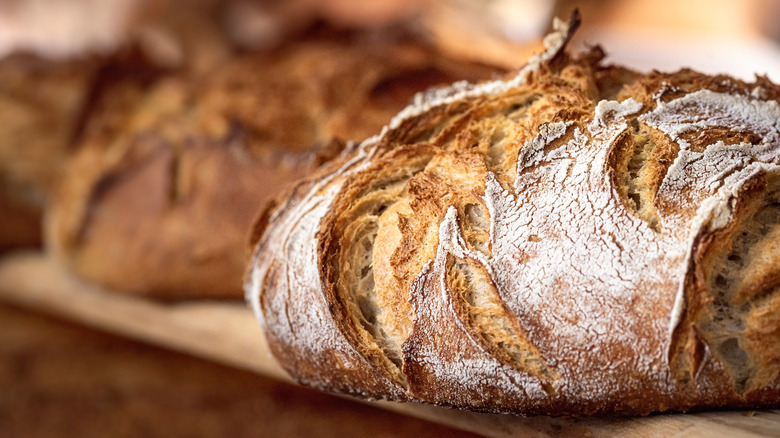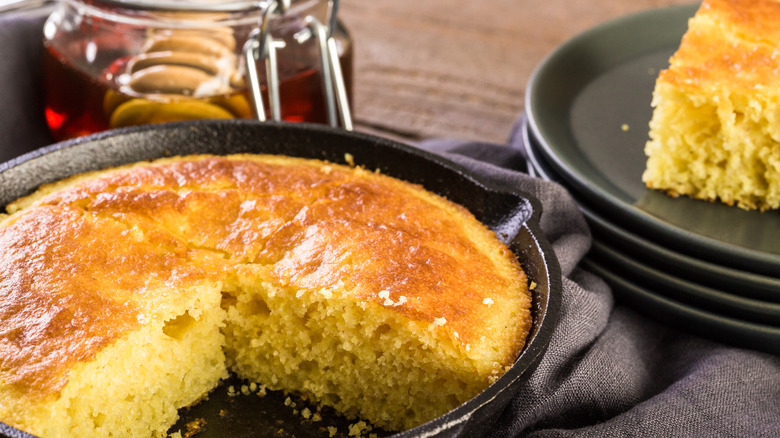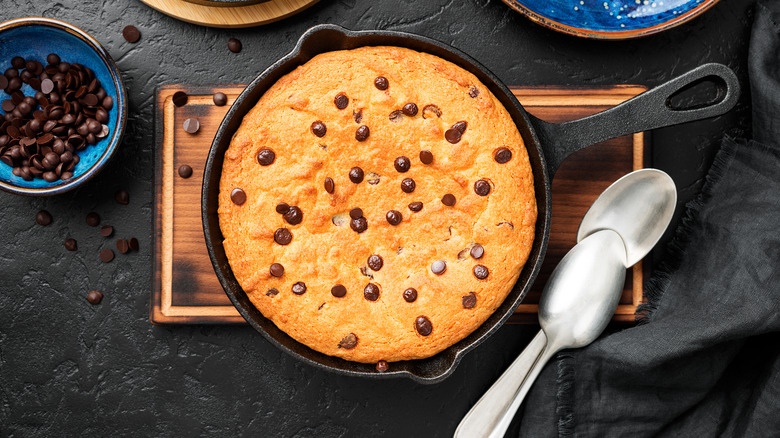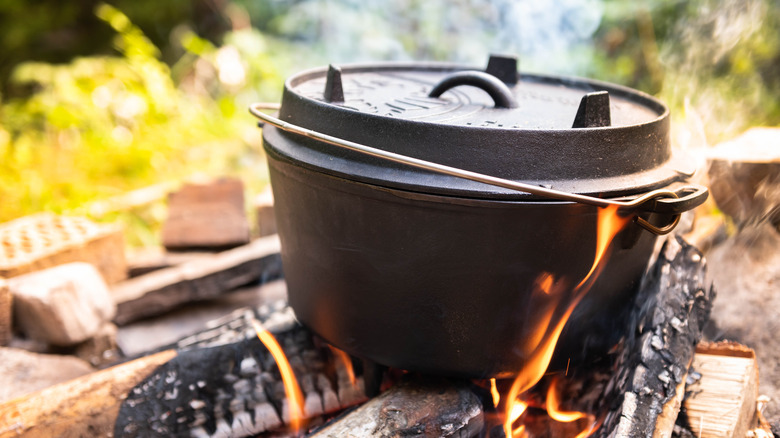Essential Tips For Baking In Your Cast Iron Pan
We may receive a commission on purchases made from links.
You probably have a cast iron pot or pan hanging around your kitchen — but are you making the most of it? If you've been keeping yours on top of the stove, then you are not. While cast iron pots and pans are great for frying and boiling, they work just as well in the oven. They can pull double duty, going from a soup tureen to a bread pan to a frying pan to a pie plate.
Cooks love cast iron pans because they easily transition from the stovetop to the oven. That means that you can start some dishes, like frittatas, on the stovetop, then finish them with a quick bake in the oven. Not only does that make baking a breeze but it means you have one fewer dish to clean when you are done. You can use these pans to bake beans, breads, pies, and more. If you have never tried baking in a cast iron pan, now is the time.
Benefits to baking in your cast iron pan
There are many benefits to baking in a cast iron pan, and one is that cast iron is economical. Brand-new cast iron pans start at $10 to $20 (via Amazon), although you can certainly spend more. But you can probably score a cast iron pan for even less at a yard sale or a thrift shop, and it should be just as good as a new dish after you scrub off any rust.
Cast iron pans are also sustainable. Buy a new one today and it will last you forever. Even better, buy that used pan at the thrift store. As long as you take proper care of it and prevent it from rusting, you should be able to pass your cast iron pan down to your kids and grandkids.
Baking in cast iron cookware may also benefit your health. According to a 2019 study published in the journal PLoS One, using iron-containing cookware may reduce iron-deficiency anemia, especially in children. Worldwide, roughly one billion people, primarily children and women of childbearing age, suffer from iron-deficiency anemia. Using cast iron pots and pans is a relatively easy and cost-effective step toward a solution.
How to choose a cast iron pan
A cast iron pan is a great investment that will last you for years. When choosing a cast iron pan, you should consider several factors such as the number of people in your family and the size of your oven and stovetop. Select a piece that is large enough to cook for your whole family or you'll end up in the market for another one. Take a look at your oven and stovetop before you buy, though — if either one is undersized, you may end up with a piece that doesn't fit.
As with any purchase, price is critical when it comes to choosing a cast iron pan. In general, cast iron pans are a budget-friendly investment. For example, this mid-size cast iron skillet from Lodge is just $19.95, and there are both larger and smaller versions available at other price points. You should be able to find a piece that fits your needs and budget.
If you inherit a cast iron piece or find a great deal on one at a yard sale or thrift shop, go for it. Cast iron is so versatile that you can probably make do with what you find even if it is not exactly what you are looking for. For example, while a skillet is the perfect shape for making a frittata, there's nothing to stop you from making one in a Dutch oven. Don't overlook a score just because it doesn't meet all your expectations.
Season your cast iron pan before using it
Once you choose your cast iron pan, you need to season it. Seasoning a cast iron pan involves heating oil in the pan, which causes a chemical reaction between the metal in the pan and the oil. The result is a thin, protective layer that will prevent the pan from rusting and will also keep food from sticking to it when you cook.
The Field Company provides thorough instructions on how to season your cast iron pan. Start by preheating your oven to 200 degrees Fahrenheit. At the same time, heat your pan on the stovetop to make sure it is completely dry. Next, place your pan in the oven for ten minutes. Then, take it out while you increase the oven temperature to 300 Fahrenheit. While the oven preheats, coat your pan on all sides with an unsaturated oil such as sunflower oil or grapeseed oil. When exposed to heat, these oils form a thick, hard layer that protects the cast iron.
Once you have applied a thin coating of oil, place your pan upside down on the middle rack of the oven. After ten minutes, take it out and wipe off any excess oil while you increase the temperature to 400 degrees. Then leave it in the oven for one hour without opening the door. After this initial seasoning, simply cooking and baking with your pan will keep it seasoned, but you can always re-season it if you like.
Preheat your cast iron pan before baking
When you cook on the stovetop, you probably heat up your cast iron pan before adding any food. In the same way, you may want to pre-heat your cast iron pan before baking in it. How you preheat your pan depends on what you are planning to bake in it.
For something like a frittata that starts on the stove, then transitions to the oven, preheat your cast iron pan on the stovetop. The Michigan State University Extension recommends the pop and sizzle method for preheating cast iron on the stovetop. Simply place your pan on the burner for about five minutes, rotating it periodically. Throw a few drops of water onto the pan to see if it is ready. If the water pops and sizzles, you are good to go. If it evaporates immediately, the pan is too hot. Let it cool for a minute or two before starting to cook.
If you plan to bake bread in your cast iron pan, preheat the pan in the oven beforehand. Lodge recommends heating your Dutch oven or other cast iron pan in the oven for 40 minutes at a temperature that is 50 degrees higher than the baking temperature. Heating the pan to a higher temperature compensates for the heat loss that occurs when you take it out of the oven to place the bread dough in the pan. Be sure to sprinkle cornmeal in the pan or your loaf will stick.
Keep an eye on the time
Cast iron pans heat up and retain heat better than other bakeware (per Lodge), which means you may need to adjust baking times when your bake in your cast iron pan. Otherwise, your baked goods might end up overcooked or even burned. When trying a recipe in a cast iron pan for the first time, reduce the baking time by five minutes. At that time, check to see if it is done. For many baked goods, you can do so by inserting a clean toothpick into the center. If it comes out wet or with batter sticking to it, put it back in the oven for a few minutes. It's better to check it too early than pull out a dish that is burnt or dry.
Lodge recommends letting your dish cool in the cast iron pan for about five minutes if you plan to serve it from another dish or platter. To loosen your dish from the pan, simply run a butter knife around the sides. Then, grab the handles and flip the pan upside-down onto a cooling rack to turn out the finished product. Make sure to jot down a few notes in your cookbook about what worked (or didn't work) or how long to bake a particular recipe in cast iron. There's no need to experiment every single time you make something.
Experiment with different pans
One great thing about cast iron pans is their versatility. For many recipes, you can swap out one cast iron pan for another without a huge difference in the results. Most of the time, you'll probably end up with a baked good that tastes the same but has a different shape.
For example, this recipe for sourdough bread calls for a Dutch oven with a lid. It even recommends an oval-shaped Dutch oven for best results. However, you could certainly use a round Dutch oven with a lid, or even a cast iron skillet covered with tin foil. Don't be afraid to experiment with the cast iron pans that you have.
While you can make most recipes in any cast iron pan, you should consider a few points before getting started. Think about the size of the baked goods you want to make, both in terms of area and volume. If you are baking bread, will it rise up and spill over the sides? If you are making brownies, will the batter spread too thin and burn quickly? Think your recipe through from start to finish before popping it in the oven.
Relax—you (probably) can't ruin your cast iron pan
Don't be nervous when cooking or baking with your cast iron pan. These pieces are extremely durable, which is why so many people have pans that they inherited from their parents or grandparents. Unlike enamel-coated dishes that are easy to scratch or scrape, cast iron pans can handle metal spoons and spatulas. And unlike ceramic pots that can shatter, you won't break cast iron pans if you bang them against the counter. So, while you shouldn't mistreat your cast iron pans on purpose, you probably don't need to worry about accidentally ruining them.
If you do accidentally burn something to the bottom of a cast iron skillet or your Dutch oven rusts because you left it out wet, you can still salvage it. Lodge recommends scrubbing the pan with steel wool to remove all rust, then washing it in warm, soapy water. Next, dry it with a lint-free cloth or by heating it on the stovetop. Once it is dry, season your cast iron pan and it should be good as new. If it feels sticky when you finish seasoning it, simply place it back in the hot oven for an extra hour to burn off any excess oil.
Cast iron is great for savory baked dishes
Once you have seasoned your cast iron pan, get ready to start baking! Savory dishes work well in cast iron. Many savory meals, like frittatas and Dutch babies, start on the stovetop but end up in the oven, and cast iron easily makes that transition. Plus, with their rustic vibe, cast iron pans can work as serving dishes, reducing the number of pots and pans you have to wash at the end of the meal.
Try this Vegetable and Cheese Frittata in your cast iron skillet. Simply whisk together eggs, milk, your favorite cheese, and some chopped veggies and pour into the skillet. Briefly cook on the stovetop, then transfer to the oven once the eggs are set. Add a salad and a loaf of bread and you have dinner.
Another savory recipe that works well in a cast iron skillet is this Roasted Mushroom and Bacon Dutch Baby from the Boston Herald. Preheat your cast iron skillet in the oven alongside the roasting bacon and mushrooms while you make a savory pancake batter in the blender. Pour the batter into the skillet, bake, then top with cheese, roasted mushrooms, and bacon. Baked beans also work well in a cast iron pan. The secret to baked beans is to cook them for a long time at a low temperature, around 325 Fahrenheit.
Try baking bread in your cast iron pan
Bread pans are great for baking perfectly shaped loaves of bread but baking bread in cast iron pans gives it a rustic twist. Yeast breads come out great in cast iron pans like Dutch ovens.
If you joined the crowd in baking sourdough bread during the pandemic, you will love making this famous New York Times recipe for No-Knead Sourdough Bread in your cast iron Dutch oven. Preheat the Dutch oven for about half an hour before your loaf finishes rising. Bake with the cover on for 30 minutes, then another 15 to 30 minutes with the cover off.
You can try any other yeast bread recipe you love in cast iron as well. Lodge recommends using parchment paper when baking yeast breads in a cast iron pan. Let your dough rise on the parchment paper, then transfer the paper to the pan before placing it in the oven. The parchment paper will make transferring the dough easy and will also prevent it from sticking to the cast iron pan.
Bake quick breads in your cast iron skillet
Cast iron pans are not just for yeast breads — quick breads come out great, too. Quick breads generally rely on baking powder or baking soda as opposed to yeast to rise. Cornbread is a classic quick bread recipe that cooks have been baking in cast iron skillets for years. Try this cast-iron cornbread recipe as a side dish the next time you make chili or beans.
Biscuits are another quick bread that works well in a cast iron skillet. Whether you make your own from scratch or pop them out of a can, biscuits nestled together in a cast iron skillet will come out soft on the inside and crispy on the outside. They're perfect for breakfast or as a side dish with dinner.
Feel free to experiment with your favorite quick bread or muffin recipes. You can serve cornbread in wedges or as muffins, so why not banana bread or pumpkin bread? Just keep an eye on your bread to prevent overbaking.
You can make dessert in a cast iron pan
Cast iron is not just for cooking dinner (or breakfast). You can also bake desserts in your cast iron pans for a rustic twist on classic recipes. For example, a basic dessert like chocolate chip cookies transforms into a Giant Gooey Chocolate Chip Cookie when baked in a cast iron skillet. Cast iron desserts are great for entertaining.
You can try other recipes like cake, pie, or brownies in a cast iron skillet, so choose your favorite and give it a whirl. Before you get started, consider the end result of the standard recipe. If the overall size is close to the size of your skillet, go ahead and bake it just like you always do. But if not, you may need to adjust your recipe or the cooking time. If your typical brownie recipe uses an 8-inch by 8-inch pan but your skillet is twice as big, you might need to double the recipe or reduce the cooking time. But what could be more fun than experimenting with dessert recipes?
How to bake over the campfire with your cast iron pan
Cast iron pans are not just for the kitchen. Campers everywhere know the value of a Dutch oven at a campsite. You can use them to make bacon and eggs for breakfast, beans for lunch, and stew for dinner, which means you only have to lug one pot with you to the campground. Cast iron can withstand the heat of a campfire—just be prepared to wipe the soot off at the end of your trip.
KOA provides a recipe for Easy Campfire Peach Cobbler that uses easy-to-pack ingredients and is designed to bake over the fire. All you have to do is dump sliced, canned peaches in the bottom of your Dutch oven, cover with the dry contents of boxed cake mix, then slice a stick of butter on top. Bake over the campfire and enjoy. Feel free to swap out canned apples, pears, or cherry pie filling for something a little bit different.


